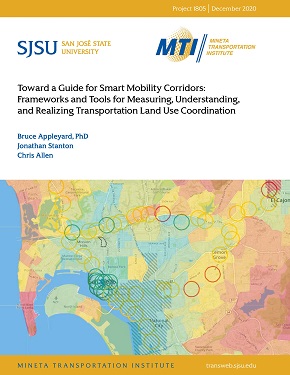- 408-924-7560
- mineta-institute@sjsu.edu
- Donate
Toward a Guide for Smart Mobility Corridors: Frameworks and Tools for Measuring, Understanding, and Realizing Transportation Land Use Coordination
The coordination of transportation and land use (also known as “smart growth”) has been a long-standing goal for planning and engineering professionals, but to this day it remains an elusive concept to realize. Leaving us with this central question -- how can we best achieve transportation and land use coordination at the corridor level?
In response, this report provides a review of literature and practice related to sustainability, livability, and equity (SLE) with a focus on corridor-level planning. Using Caltrans’ Corridor Planning Process Guide and Smart Mobility Framework as guideposts, this report also reviews various principles, performance measures, and place typology frameworks, along with current mapping and planning support tools (PSTs). The aim being to serve as a guidebook that agency staff can use for reference, synergizing planning insights from various data sources that had not previously been brought together in a practical frame.
With this knowledge and understanding, a key section provides a discussion of tools and metrics and how they can be used in corridor planning. For illustration purposes, this report uses the Smart Mobility Calculator (https://smartmobilitycalculator. netlify.app/), a novel online tool designed to make key data easily available for all stakeholders to make better decisions. For more information on this tool, see https://transweb.sjsu.edu/research/1899-Smart-Growth-Equity-Framework-Tool. The Smart Mobility Calculator is unique in that it incorporates statewide datasets on urban quality and livability which are then communicated through a straightforward visualization planners can readily use.
Core sections of this report cover the framework and concepts upon which the Smart Mobility Calculator is built and provides examples of its functionality and implementation capabilities. The Calculator is designed to complement policies to help a variety of agencies (MPOs, DOTs, and local land use authorities) achieve coordination and balance between transportation and land use at the corridor level.
BRUCE APPLEYARD, PhD
Dr. Appleyard is an Associate Professor of City Planning at San Diego State University (SDSU) and the Assistant Director of Active Transportation Research (ATR) where he helps people and agencies make more informed decisions about how we live, work, and thrive. Working from the human to regional/ecosystem scale, he is an author of numerous peer- reviewed and professional publications, and is a renowned expert on urban quality, the future of transport, street livability and design for pedestrians and bicyclists. He also has expertise in coordinating housing, land use, and transport to help places become more sustainable, livable, and equitable. For more, see his online Smart Mobility Calculator https://smartmobilitycalculator.netlify.app/ - a planning support tool (PSTs) designed to help people take action to coordinate transport, housing, and climate action planning.
He recently served as a Guest Editor for the Special Issue celebrating 25 years of Transit Oriented Development (TOD) in the Journal of Planning Education & Research, and just published Livable Streets 2.0 about the conflict, power, and promise of our streets https://www.elsevier.com/books/livable-streets-20/appleyard/978-0-12-816028-2
In 2006, The Robert Wood Johnson Foundation named Dr. Appleyard, alongside Barack Obama, as one of their Top Ten “Active Living Heroes” for his work helping communities.
Dr. Appleyard holds a Doctorate (as well as a Masters and Bachelors) from the University of California in the town of Berkeley where he grew up.
JONATHAN STANTON
Jonathan Stanton is a Master’s of City Planning student at San Diego State University and a Student Worker for the County of San Diego in the Advance Planning division. Jonathan supports academic researchers at SDSU studying active transportation as well as land use planning and transportation planning, and he is currently focused on studying vehicle miles travelled (VMT) in the state of California. He completed a Bachelor’s of Science from UC Davis in Environmental Policy Analysis and Planning, and has previously worked in the field of air quality testing, collecting and analyzing emissions data from stationary sources such as power generating plants, refineries, and cement plants.
CHRIS ALLEN
Chris is a PhD student in geography at San Diego State University, where he focuses on studying livability with GIS and machine learning methods. He also works as a data visualization product engineer at ESRI.
-
Contact Us
San José State University One Washington Square, San Jose, CA 95192 Phone: 408-924-7560 Email: mineta-institute@sjsu.edu






